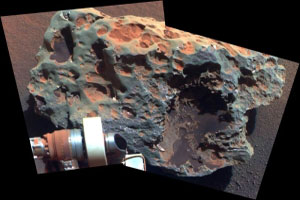 Block Island—a half-ton meteorite found on Mars by NASA's
Block Island—a half-ton meteorite found on Mars by NASA's
Opportunity rover.Image credit, NASA/MER OpportunityEver been driving down a lonely desert highway when you suddenly glimpse something in the corner of your eye that makes you think, "What was that?!" You brake, tires screech, you spin the wheel and make a wild U-turn, cutting into the shoulder and leaving a rooster-tail of dust as you floor the gas to get back to what you thought you saw….
Okay, dramatic desert car scene ended. That would be the Hollywood movie version of what NASA's Mars Exploration Rover Opportunity did recently, on the lonely desert highway that it's scouting on Mars.
On its determined long trek from Victoria Crater to the larger Endeavour Crater (a 12-mile span that Opportunity has completed about one fifth of over the past year), the rover passed by an X-box-sized block of iron that presented the appearance of a meteorite. It snapped a picture in passing, which was eventually transmitted to Earth and examined. By this time, Opportunity had already traveled about 180 meters beyond the block (dubbed "Block Island"). This is when the rover was commanded to backtrack all the way to the find (though it's doubtful it worked up a rooster tail).
Upon returning to Block Island—quite obviously an iron-nickel meteorite by appearance alone, but whose composition was confirmed by the rover's alpha particle X-ray spectrometer instrument—Opportunity took more pictures, including extreme close-ups with its microscope camera, which revealed surface patterns similar to those found on Earth iron-nickel meteorites that have been exposed to long-term weathering by wind and sand.
As interesting as stumbling upon a half-ton meteorite on the dusty plains of Mars' Meridiani Planum is, what this particular chunk of weathered iron is telling scientists sparks the imagination. In a nutshell, given the thinness of Mars' current atmosphere, scientists wouldn't expect a meteorite of this size to survive impact intact, at the speed it would be going. One of the possible explanations for Block Island's rock-houndable state is that when it fell to Mars, Mars' atmosphere was substantially thicker than it is now.
